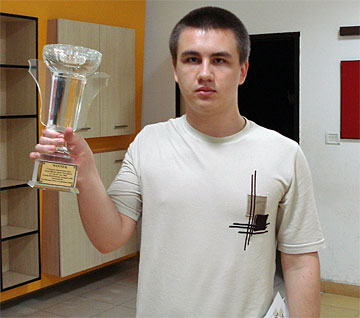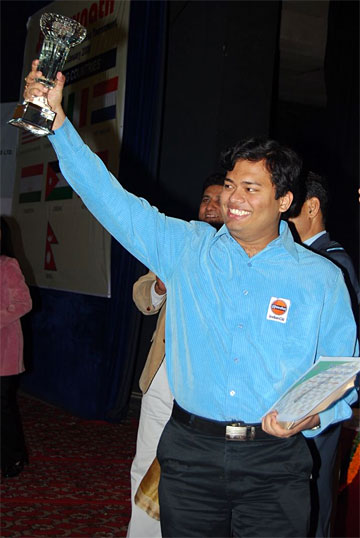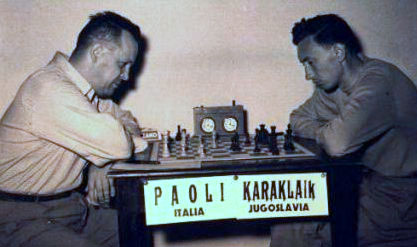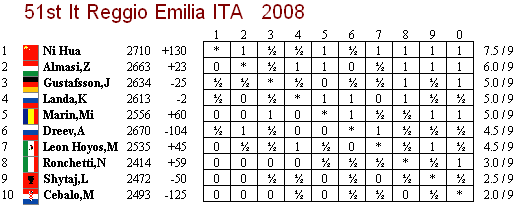by Milan Bjelajac, Informant@ChessCafe
Viswanathan Anand showed that he was in good spirits and had great
ambitions to fight for the World Championship title in Mexico City. His
victory against Aronian in the second round of this tournament was voted
as the best game of Volume 101.
Anand, as black in a very popular variation of Semi-Slav Defense, played
the very strong novelty 17…c5!. It came as such a surprise to Aronian
that he followed up with the unnecessary 19.Kh1?! and the weak 21.
Nd5?. Anand began a strong counter-attack with the excellent 22…Be5!
and kept an initiative until the end of the game.
There are also many other interesting and beautiful games in Volume 101.
Of note are the games Ivanchuk–Bacrot, Bruzon–Ivanchuk, and Kramnik–
Aronian. The former received just slightly fewer points than Aronian–
Anand. We hope you enjoy these fine achievements.
1. Aronian 2750 – V.Anand 2792Mexico City 2007 — 101/337 [D43]1.d4 Nf6 2.c4 e6 3.Nf3 d5 4.Nc3 c6 5.Bg5 h6 6.Bh4 dc4 7.e4 g5 8.Bg3
b5 9.Ne5 h5 10.h4 g4 11.Be2 Bb7 12.0-0 Nbd7 13.Qc2 Ne5 14.Be5 Bg7
15.Rad1 0-0 16.Bg3 Nd7 17.f3 c5! [a novelty; 17...Qb6 see 93/368] 18.
dc5 [18.Nb5 cd4 19.Nd4? Qb6 20.Bf2 g3! 21.Be3 Qd8 with the idea 22.
Bg5? Bd4 23.Rd4 Qb6 and Black is winning; 18.d5 Be5 19.f4 Bd4 weak
point Be2] Qe7 19.Kh1?! [19.Bd6 Qh4 20.g3 Qh3 21.Rf2 Ne5!; 19.Rd6
a6! 20.c6 Bc6 21.Rc6 Ne5 22.Rb6 Qa7 23.Bf2 g3 24.Be3 Qe7! and Black
is superior; 19.fg4 Qc5 20.Bf2 Qc6 21.gh5 Ne5 with compensation; 19.
Rf2!?] a6 20.a4 Bc6 21.Nd5? [21.Rd6 Be5 22.Rd7 Bd7 23.Be5 Qh4 24.
Kg1 g3 and Black is superior; 21.ab5 ab5 22.Nd5 ed5 23.ed5 Be5 24.f4
Bg7 25.dc6 Nc5 26.Rd5 Ra2; 25...Nf6; 21.fg4! hg4 22.Nd5 ed5 23.ed5
Nc5 (23...Be5? 24.Rf5!) 24.dc6 Ne4] ed5 22.ed5
22...Be5! 23.f4 Bg7 24.dc6 [24.Rfe1 Qc5 (24...Nc5 25.Bc4) 25.dc6 Qc6
a) 26.Bd3 Nc5 27.Bh7 Kh8 28.ab5 ab5 29.Qf5 Na4 (29...Nd3? 30.Qh5)
30.Qh5 Qh6 31.Qh6 Bh6 32.Be4 Nb2 33.Rd6 Bg7 34.Ba8 Ra8; b) 26.b3
Nc5 27.ab5 ab5 28.bc4 Ne4 (28...b4 29.Rd5 b3 30.Qf5) 29.Kh2 Ng3 30.
Kg3 Ra3 and Black is superior] Nc5 [24...Nf6 25.f5 Qc5 26.Bd6 Qc6 27.
Bf8 Rf8] 25.Rd5 Ne4 26.Be1 Qe6 27.Rh5 [27.ab5 Qd5 28.Bc4 Qd4 29.
b6 (29.Bd3; 29.ba6 Rfe8 30.b3 g3 and Black is winning) Nd6 and Black
is winning] f5! [weak point Rh5; 27...Qg6 28.f5 Qh5 29.Qe4] 28.Kh2
Rac8 29.Bb4 Rfe8 30.ab5 ab5 31.Re1 Qf7 32.Rg5 Ng5 33.fg5 [33.hg5
Qh5 (33...Bd4 34.Bf1 Be3 and Black is winning) 34.Kg3 Re3 35.Kf2
Bd4?? 36.Bc4!; 35...Re4! and Black is winning] Rc6 [33...Re3? 34.Bc4!]
34.Bf1 [34.Rf1 Rce6 35.Bd1 Qc7 36.g3 Re3 and Black is winning] Re1
35.Be1 Re6 36.Bc3 Qc7 37.g3 Re3 38.Qg2 [38.Qf2 f4] Bc3 39.bc3 f4 40.
Qa8 Kg7 41.Qa6 fg3 [42.Kg1 Qf7 43.Qh6 Kg8] 0-1 [V.Anand]
2. Ivanchuk 2787 – Bacrot 2695Hersonissos 2007 — 101/299 [D15]1.d4 d5 2.c4 c6 3.Nf3 Nf6 4.Nc3 a6 5.c5 Nbd7 6.Bf4 Nh5 7.Bd2 Nhf6 8.
Qc2 g6 9.g3 [9.e4 see 96/279] e5 10.de5 Ng4 11.e6 Nc5 12.ef7 Kf7 13.e4
Bg7 14.Bg2 Bc3! [a novelty; 14...Re8] 15.Bc3 de4 16.Bh8 [16.Nd2 a)
16...e3 17.0-0 a1) 17...ed2 18.Bh8 Qh8 19.Qc5 and White is superior; a2)
17...Bf5 18.Ne4 ef2 19.Rf2 Nf2 20.Qf2 Nd3 21.Qe3 Re8 22.Rd1 Re4 23.
Be4 Qe7 24.Rd3 Qe4 (24...Be4 25.Rd1 and White is superior) 25.Rd7
Ke6 26.Qd2 Qb1 27.Kf2 Qc2 and White is slightly better; a3) 17...ef2 18.
Rf2 Nf2 19.Bh8 Nh3 20.Kh1 Nf2 equal; b) 16...Nd3 17.Kf1 Ndf2 18.Qb3
Be6 19.Qb7 Qe7 20.Qe7 Ke7 21.Bh8 Rh8 22.Ne4 Nh1 23.Bh1 Rb8 24.b3
Nh2 25.Kg1 Ng4 and Black is slightly better; c) 16...Qd3! 17.Qd3 Nd3 18.
Ke2 Re8 and Black is slightly better] Nd3 17.Kf1 [17.Ke2 ef3 18.Bf3
Qh8 19.Qb3 Kf8 20.Kd3 Bf5 21.Ke2 Qd4 22.Bg4 Bg4 23.Kf1 Qe4 with
attack] ef3 18.Bf3 Ngf2 19.Qb3 Ke7 20.Bg7 [20.Qa3 c5 21.Re1 Ne1 22.
Qc5 Qd6 (22...Ke8 23.Qe3 Qe7 24.Kf2 Qe3 25.Ke3 Nf3 26.Kf3 equal) 23.
Bf6 Ke6 24.Qd6 Kd6 25.Kf2 Nf3 26.Kf3 equal] Bh3! [20...Nh1 21.Bh1
Bh3 22.Kg1 and White is slightly better] 21.Bg2? [21.Kg1! a) 21...b5? 22.
Qc3 Qd6 23.Bh6 Nh1 (23...Qf6 24.Re1 Kf7 25.Re3 Qc3 26.bc3 and White
is superior) 24.Kh1 Kd7 25.Qg7 Kc8 26.Be3 with initiative; b) 21...Qd7
22.Bh6 Re8 23.Bg5 Kf8 24.Bh6 equal] Qd7 22.Bh3 [22.Re1 Ne1 23.Bh3
Nh3 and Black is winning] Qh3 23.Kg1
23...Qf5! [23...Qg4? 24.Re1! Ne1 25.Kf2! and White is winning] 24.
Qb7?! [24.Re1!? a) 24...Ne1 25.Qb7 Kd6 26.Qb4 Kd5 (26...Kc7 27.Qe7;
26...c5 27.Qb6 Kd5 28.Qb7 Ke6 29.Qb3 Qd5 30.Qd5 Kd5 31.Kf2 equal)
27.Qd4 Ke6 28.Qc4 (28.Qf2 Qe4 29.Qf6 Kd5 30.Qg5 Kc4 31.Qf4 Qf4 32.
gf4 Nd3 33.Kg2 Nf4 34.Kf3 Ne6 35.Bc3 and Black is superior) Kd7 (28...
Ke7 29.Qb4) 29.Qd4 Kc7 30.Qf2 Qe4 31.Qf4 Qf4 32.gf4 Nd3 33.Kg2
Nf4 34.Kf3 Ne6 35.Bc3 and Black is superior; b) 24...Kd6! 25.Re3 Rd8
26.Bd4 b5 27.h3 (27.Kg2 Kc7 and Black is winning) Rf8 28.Kg2 h5‡ 29.
a4 (29.Qa3 b4 30.Qb3 Kc7 31.h4 c5 32.Bg7 Rf7 and Black is winning)
Kc7 (29...c5 30.Bg7 Rf7 31.ab5 ab5 and Black is superior) 30.ab5 Ng4
31.Re7 Kd8 32.hg4 Qf3 33.Kh2 Ke7 and Black is superior; 24.h4 Qf3 25.
Re1 (25.Rh2 Qg3 26.Kf1 Qf3 and Black is winning) Ne1 26.Qf3 Nf3 27.
Kf2 Nd2 and Black is superior] Kd6 25.Qb6 Qf3 26.Qd4 Kc7 27.Be5
Kc8 0-1 [Ivanchuk, Sulypa]
3. Bruzon Batista 2607 – Ivanchuk 2787Merida (m/1) 2007 — 101/218 [C43]1.e4 e5 2.Nf3 Nf6 3.d4 Ne4 4.de5 Bc5 5.Qd5 [5.Bc4] Bf2 6.Kd1!? [6.
Ke2 f5 7.Nbd2 c6 8.Qd3 Qe7 unclear] f5! [6...Nc5?! 7.Bg5 c6 8.Qd2 Ne4
9.Bd8 Nd2 10.Nbd2 Kd8 11.Ne4 Bb6 12.Nd6 with initiative] 7.Bc4 Qe7
[7...Rf8 8.Nc3 c6 9.Ne4 cd5 10.Nd6 Ke7 11.Bg5 Rf6 12.Bd5 Nc6!
unclear] 8.Nc3 [a novelty; 8.Nbd2 c6 9.Qd3 Bc5 10.Rf1 (10.Ne4 fe4 11.
Qe4 d5!) Nf2 11.Rf2 Bf2 12.Qf5 unclear; 8.Rf1 a) 8...Nc6 9.c3 (9.Nc3
Nb4!) Bb6 10.Nbd2 Nc5 11.Nb3 Ne6 12.Kc2 with compensation; b) 8...
c6 9.Qd3 Bb6 10.Nc3 with compensation] c6 9.Qd3 b5! [9...Bb6 10.Rf1!
Nf2 11.Rf2 Bf2 12.Ke2 Bc5 13.Bg5! with attack; 9...Na6 10.Ba6 ba6 11.
Rf1! with initiative] 10.Bb3 a5!? [10...Na6 11.Ne4 fe4 12.Qe4 Nc5 13.
Qe2 Nb3 14.ab3 Bc5 15.Bg5 Qf7 16.Be3 with compensation] 11.a4 b4!
[11...ba4 12.Ra4 Na6 13.Ne4 fe4 14.Qe4 Nc5 15.Bg5 Ne4 (15...Qf8 16.
Qe2 Na4 17.Ba4 with compensation) 16.Be7 Ke7 17.Re4 equal] 12.Ne4
fe4 13.Qe2 [13.Qe4 d5 14.Qf4 Nd7 and Black is slightly better] d5 14.
ed6 [14.Qf2 ef3 15.Qf3 (15.gf3? 0-0 with initiative) Qh4! (with the idea
Bg4) 16.e6 (16.h3 Rf8 with initiative) Rf8 17.Qg3 (17.Qe3 Rf6! with
initiative) Qh5 18.Ke1 Ba6 and Black is superior] Qd6 15.Bd2 e3 16.Rf1
[16.Bc4 Ba6!] Ba6 17.Bc4 Bc4 18.Qc4 Ra7! [with the idea Re7; 18...Nd7
19.Ke2 ed2 20.Rf2 unclear] 19.Ke2 Re7 20.Be1 [20.Rad1 Qg6 21.Rf2
ef2 22.Kf2 Rf8 and Black is winning]
20...Qg6! [weak points c2, g2] 21.g3 (only move) Re4! 22.Qd3 [22.Qa2
Be1 23.Rae1 Rf8 24.Nh4 Qg4 25.Rf3 Rf3 26.Nf3 Re6 and Black is
winning, zugzwang] Nd7! 23.Rd1 [23.Bf2 Nc5! (23...ef2? 24.Kf2 Nc5 25.
Qd2 0-0 26.Kg1 with counterplay) 24.Qd1 Qe6 (24...Qh6 25.Bg1 0-0 with
attack) 25.Be3 (25.Bg1? Qc4) Re3 26.Kf2 0-0 27.Kg1 Re2 and Black is
winning] 0-0! and Black is winning [23...Qf5? 24.Bf2 ef2 25.Kf2 0-0 26.
Qd7 Qf3 27.Kg1 equal] 24.Qd7 Qh5 25.g4 Qh3 26.Ng5 Qg2 27.Bf2 Rf2
28.Rf2 ef2 0-1 [Ivanchuk]
4. Kramnik 2769 – Aronian 2750Mexico City 2007 — 101/419 [E15]1.d4 Nf6 2.c4 e6 3.Nf3 b6 4.g3 Ba6 5.b3 Bb4 6.Bd2 Be7 7.Bg2 c6 8.Bc3
d5 9.Ne5 Nfd7 10.Nd7 Nd7 11.Nd2 0-0 12.0-0 Rc8 13.e4 de4 14.Ne4 b5
15.Re1 bc4 16.Bf1 Nb6
17.Rb1! [a novelty; 17.Nc5 see 95/(370)] Nd5 [17...c5 18.dc5 Bc5 19.
Qh5 Qd5 20.Qh4 and White is superior; 17...Rb8 18.bc4 (18.Nc5 Bb5 19.
a4 Nd5 20.Ba1 c3 21.ab5 cb5 22.b4 a5 23.Bg2 ab4 24.Bd5 and White is
superior) Nc4 (18...Bc4 19.Rb6 and White is superior) 19.Rb8 Qb8 20.
Nc5 Nb2 21.Bb2 Bf1 22.Ba3 Bh3 23.Qh5 (23.Nd7 Qb7) Bf5 24.Nd7 and
White is superior] 18.Ba1 Bb4 [18...Qa5 19.bc4 Nb6 20.Qc2 and White is
superior; 18...Rb8 19.bc4 (19.Nc5) Rb1 20.Qb1 and White is superior] 19.
Nc5! [19.bc4 Be1 20.Qe1 Nb6 21.Qc3 with initiative] Be1 [19...Qa5 20.
bc4! Be1 21.Qe1 Qe1 22.Re1 Nc7 23.Bc3 and White is superior, with the
idea Ba5; 19...Nc3 20.Bc3 Bc3 21.Re4 and White is superior, with the
idea 21...Qa5 22.b4 Qa2 23.Na6 Qa6 24.Qc2] 20.Qe1 cb3 [20...Nc7 21.
bc4 and White is superior] 21.Na6 [21.Ba6 ba2 22.Rb2 Rb8 23.Ra2 Nb4
and White is slightly better] ba2 22.Rb2 Nc7 [22...Re8 23.Ra2 Re7] 23.
Ra2 (and White is superior) Na6 [better is 23...Nb5!?] 24.Ra6 Qd7 [24...
c5 25.Qe5! c4 (25...cd4 26.Bd4 f6 27.Qe6 Kh8 28.Be3 Re8 29.Qb3 and
White is winning; 25...Qd5 26.dc5 and White is winning, with the idea
26...Qe5 27.Be5 Rc5 28.Bd6) 26.d5 Qf6 27.Qf6 gf6 28.Bf6 ed5 (28...c3
29.Ra4 Rfe8 30.Rg4 Kf8 31.Rg7 and White is winning) 29.Bh3 and White
is superior] 25.Qc3 f6 26.Qc5 Rf7 27.Bc3 Qb7 [27...Kh8 28.Bc4; 27...
Qd5 28.Bc4 Qc5 (28...Qe4 29.Ra1) 29.dc5 Re7 30.Ra7 Kf8 31.Ra6 and
White is superior] 28.Qc4 Qd7 29.Bg2 Kh8 30.Bc6 Qb7 31.Kg2! (and
White is winning) h6 [31...Re7 32.Bb4 Ree8 33.Bd6 Red8 34.Qa4 Qb1
35.Be7 Rg8 36.Bc5] 32.d5 Qb8 [32...ed5 33.Bb7 Rc4 34.Bd5] 33.de6
Re7 34.Bb4 Rec7 35.e7 1-0 [Kramnik]
5. M.Carlsen 2714 – Mi.Adams 2729Khanty-Mansiysk (m/1) 2007 — 101/434 [E36]1.d4 Nf6 2.c4 e6 3.Nc3 Bb4 4.Qc2 d5 5.a3 Bc3 6.Qc3 dc4 7.Qc4 b6 8.
Bf4 Ba6 9.Qc7 Qc7 10.Bc7 0-0 [a novelty; 10...Nbd7 see 101/(434)] 11.
Nf3 Rc8 12.Bf4 Nbd7 13.Nd2!? Rc2 [better is 13...Nh5! unclear] 14.Rb1
[14.e4 Bf1 15.Rf1 Rb2 and Black is slightly better] Rac8
15.Nb3! and White is slightly better [15.Kd1 Ng4!? 16.Bg3 f5; 15...Nh5
unclear] Bc4 [15...Nd5 16.Bd2 f5 17.Na1 R2c7 18.e3 Bf1 19.Kf1 e5 20.
de5 Ne5 21.Ke2 and White is superior] 16.Na1 Ba2 17.Nc2 Bb1 18.Na1
Nd5 19.Bd2 e5 20.e3 [20.de5 Ne5 21.e3 Bd3 (21...Nd3 22.Bd3 Bd3 23.f3
and White is slightly better) 22.Be2 and White is slightly better] ed4 21.
ed4 Nb8 [21...Re8 22.Kd1; 21...Nf8 22.Ba6 (22.f3 Ne6 23.Ba6 Rd8 24.
Kf2 Bf5 25.g4 Bg6 26.Bc4 Nd4 27.Rd1 Ne6 28.Bc1 Ndc7 29.Rd8 Nd8 and
White is slightly better) Re8 23.Kd1 Ne6 and White is slightly better] 22.
f3 Nc6 [22...Bf5!?] 23.Bc4 [23.Kf2 (M.Carlsen) Ba2 24.b3 Nd4 25.Bc4
and White is superior; better is 23...Bf5 and White is slightly better] Rd8
[23...Ncb4 (M.Carlsen) 24.b3 Nd3 25.Kf1 Nc7 26.Ke2 Re8 27.Be3 Nf4
28.Kf2 Nd3 29.Bd3 Bd3 30.Rd1 and White is superior] 24.Kf2 Bf5 25.
Nb3 Be6 26.Rc1 f6 27.a4 a5?! [27...Kf7 28.Re1 Nce7 29.g3 Nc7 and
White is slightly better] 28.Bc3 Bf7 [28...Kf7 29.Re1 Nce7 30.Nd2 and
White is superior] 29.Nd2 Nde7 30.Bf1! [30.Rd1 Bc4 31.Nc4 Nd5 and
White is slightly better] Nd4 31.Re1 Ndc6 32.Nc4 Nd5 33.Rb1 Kf8 [33...
Bg6 (M.Carlsen) 34.Rd1 Bc2 35.Rd5 (35.Rd2 Bb3 36.Nb6 Nb6 37.Rd8
Nd8 38.Ba5 Na4 39.Bd8 Nb2 equal) Rd5 36.Ne3 Bb3 37.Nd5 Bd5 and
White is slightly better; 33...Be8 34.Be1 and White is slightly better] 34.
Be1 Ke7?! [34...Bg6 35.Rd1 (35.Rc1 Ncb4) Bc2 36.Rd2 Ba4 37.Nb6 Bb3
38.Nd5 Rd5 and White is slightly better] 35.Kg1 Nb8? [35...Bg6 36.Rc1
Ncb4 37.Bf2 and White is superior; 35...Ne5 36.Ne5 fe5 37.Bh4 (37.Bf2
Rc8 unclear; 37.Rc1 Kd6 38.Bf2 Be8 39.b3 Rb8 and White is slightly
better) Nf6 38.Re1 Kd6 39.Bg3 Re8 and White is slightly better] 36.Bf2?
[36.Nb6! (M.Carlsen) Nb6 37.Ba5 a) 37...N8d7 38.Bb4 Ke6 39.Re1 a1)
39...Kf5 40.Bd3 Kg5 41.Re7 Nb8 42.Bd2 Kh5 43.g4 Kh4 44.Be1 Kg5 45.
h4 Kh6 (45...Kf4 46.Kg2 and White is winning) 46.Bd2 g5 47.Rf7 Rd3 48.
Rf6 Kg7 49.Rb6 Nd7 50.Bc3 Rc3 51.Rb7 Rd3 52.a5 and White is
winning; a2) 39...Ne5 40.Ba5 (40.f4?! Rd4 41.Bc5 Rf4 42.Bb6 Ra4 43.b3)
Rb8 41.f4 Nd5 42.fe5 fe5 43.Bb5 Be8 44.Bc4 and White is winning; a3)
39...Kd5 40.Bb5! f5 41.a5 Nc8 42.b3 and White is winning; b) 37...Rd6
38.Bb4 Nc6 39.Bd6 Kd6 40.Ra1 and White is superior] Nd7 37.Re1 Kf8
38.Rd1 Ke7 39.Re1 Kf8 40.Nd6 Ne5? [40...Nc5? 41.Nf7 Kf7 42.Bc5
bc5 43.Bc4 Rd7 44.Rd1 Ke6 45.f4 g5 46.g3 and White is winning; 40...
Bg8 41.Bb5 Ne5 42.Ne4 Rc8 and White is slightly better] 41.Nf7 Kf7 42.
Rd1 Ke7 43.f4 Ng4 44.Re1 Kf8 [44...Kd6 45.Bd4 Nf4 46.Bb6 Rb8 47.
Rd1 Ke6 48.Ba5 (48.Bc7 Rb4 49.b3 Ne5 50.Rb1 Nc6 and White is
superior) Rb2 49.Bd2 and White is superior] 45.Bd4 Rd6 46.h3 Nh6
[better is 46...Nf4 47.Re4 (47.Rd1? Ke7 48.hg4 Ne6 equal) Ne6 48.Re6
Re6 49.hg4 Re4 50.Bb6 Ra4 and White is superior] 47.Rd1 Nf5 [47...Ne7
48.Rd3] 48.Bf2 Ke7? [48...h5 49.g4 (49.g3 Ke7 and White is superior)
hg4 50.hg4 Nf4 51.Rd6 Nd6 52.Bb6 Nb7 53.Ba6 Nd5; 53.Bc4 and White
is superior] 49.g4 Nh6 [49...Nfe3? 50.Re1 Re6 51.f5 Re5 52.Bg3 Re4 53.
Bg2 and White is winning] 50.f5 Nf7 51.Bg2 Nf4 52.Rd6 Nd6 [NB 9/d]
53.Bb6 Nc4 54.Bc5 Kd7 55.Bf1 [better is 55.b3 Ng2 56.Kg2 Nd2 57.b4
Ne4 58.Bf8 Ke8 59.ba5! and White is winning] Nb2 56.Bb5 Kd8 [better
is 56...Kc7 a) 57.Bf8 a1) 57...Nh3 58.Kh2 Nf2 59.g5 fg5 60.Bg7 Nbd1 61.
Bd4 (61.f6 Ng4 62.Kg1 Ne5) Kd6 62.f6 Ng4 63.Kg1 and White is
winning; a2) 57...g6 58.Bg7 gf5 59.Bf6 Na4 60.Ba4 Nh3 61.Kg2 fg4 and
White is superior; b) 57.Kh2 Nd1 58.Bf8 g5 59.fg6 hg6 60.h4 and White
is superior] 57.Bb6 Ke7 58.Kh2! and White is winning [58.Ba5 Nh3 59.
Kh2 Ng5 60.Bb4 Kd8 61.a5 Nf3 62.Kg3 Nd4 63.Bf1 Nc6 64.a6 Kc7 65.
Bf8 g6 66.g5 and White is winning] Nd5 59.Ba5 Kd6 60.Bd2 Kc5 61.
Kg3 Nc7 62.Be3 Kb4 63.Bd2 Kc5 [63...Kb3 64.Bf4! Nd5 65.a5 Kb4 66.
Bc6 Nf4 67.a6] 64.Bc1 Nc4 65.Bc4 Kc4 [NB 4/d] 66.Bd2 Na6 67.a5
Kb5 68.Kf3 Nc5 69.Bc3 h6 [69...Na4 70.Be1 Nc5 71.Ke3] 70.Ke3 Kc4
71.Bd4 Na6 72.Ke4 Nb4 73.h4 Kb5 74.Bc3 Na6 75.Kd5 Nc5 76.Bd4
Nd3 77.Ke6 1-0 [Mi.Adams]
6. Kasimdzhanov 2690 – Predojevic 2645Deutschland 2007 — 101/305 [D17]1.d4 d5 2.c4 c6 3.Nc3 Nf6 4.Nf3 dc4 5.a4 Bf5 6.Ne5 Nbd7 7.Nc4 Qc7 8.
g3 e5 9.de5 Ne5 10.Bf4 Nfd7 11.Bg2 g5 12.Ne3 gf4 13.Nf5 0-0-0 14.
Qc2 Ng6?! 15.0-0 fg3 16.hg3 h5 17.Rfc1! Kb8 18.b4! h4 19.Nb5! [a
novelty; 19.b5 see 101/304] Qc8!? [19...Qb6 20.a5!! Qb5 (20...Qa6 21.
Nbd6 Bd6 22.Nd6 and White is winning) 21.Nd4 Qg5 22.Nc6 Kc7 23.
Qe4! and White is winning; 19...Qe5 20.Nbd4! (with attack) Rc8 21.b5
hg3 (21...c5 22.Nc6 bc6 23.bc6 Nb6 24.a5) 22.bc6 gf2 23.Kf1 Bc5 (23...
Nc5 24.Rab1 b6 25.a5 Nf4 26.ab6 Ng2 27.c7 Kb7 28.ba7 Kc7 29.Qd2) 24.
Nf3 and White is superior] 20.Qb3!! [20.Nfd6? Bd6 21.Nd6 Qc7 22.Nf7
hg3 with attack a) 23.Nd8 gf2 24.Kf2 Qf4 25.Bf3 Nde5; b) 23.Nh8 gf2
(23...Nh4!?) 24.Kf2 Nge5!? with compensation; c) 23.Qg6 gf2 24.Kf1
Ne5 25.Ne5 Qe5] h3 [20...hg3 21.Qg3 Nde5 22.Qe3 Bc5 (22...c5 23.bc5)
23.Qc5 (and White is superior) cb5 24.Qe3 (24.ab5 Qc5 25.bc5 Nf4) Qe6
(24...Qf5 25.ab5; 24...Nc4 25.Qg3 Nge5 26.Rc4 Qf5 27.Rc5 f6 28.Rb5) 25.
ab5 Qb6 26.Qb6 ab6 27.Rd1 Nf4 28.e3 and White is superior] 21.Qe3! c5
[21...Nb6 22.Na7 Ka7 23.a5 Kb8 24.ab6 Bb4 25.Ne7! (and White is
winning) Be7 26.Qb3; 21...Nc5 22.Be4 cb5 23.bc5 b4 24.c6 and White is
winning; 21...Bc5 22.bc5 hg2 23.Nfd6 Rde8 24.Qd4 and White is
winning] 22.Be4! Nf6 23.bc5 Ng4
24.c6!! Rd1 [24...Ne3 25.c7 Ka8 (25...Qc7 26.Rc7 Nd5 27.Rd1 and White
is winning) 26.cd8R Qd8 a) 27.Rab1 Nd5 (27...Nf5 28.Nc7 Qc7 29.Rc7
Nd6 30.Rcb7 Nb7 31.Rb7 f5 32.Bd5 a6 33.Kh2 Rh6 34.f4 and White is
winning) 28.Rd1 and White is superior (28.Nc7 Nc7 29.Bb7 Kb8 equal)
Nge7 29.Ne7 Qe7 30.Bd5; b) 27.Nc7 Kb8 28.Rab1! (28.Na6?! ba6 29.
Rab1 Qb6) Qc7 29.Rc7 Kc7 30.Rb7 Kc8 31.Ne3 Bc5 32.Rf7 Ne5 33.Rf5
Be3 34.fe3 h2 35.Kh1 Ng4 36.Rf3 Kc7 37.Bf5 Ne5 38.Rf4 and White is
winning] 25.Rd1 Ne3 26.Ne3 bc6 27.Rab1 cb5 [27...h2 28.Kh1 Qh3 29.
Nd6 Kc7 30.Rb7 Kd8 31.Bf5] 28.Rb5 Kc7 29.Nd5 1-0 [Kasimdzhanov]
7. V.Anand 2792 – Svidler 2735Mexico City 2007 — 101/263 [C89]1.e4 e5 2.Nf3 Nc6 3.Bb5 a6 4.Ba4 Nf6 5.0-0 Be7 6.Re1 b5 7.Bb3 0-0 8.
c3 d5 9.ed5 Nd5 10.Ne5 Ne5 11.Re5 c6 12.Re1 Bd6 13.g3 Bf5 14.d4
Qd7 15.Be3 Rae8 16.Nd2 Bg4 17.Qc2 Bf5 18.Qc1 Re7 [18...Re6 see
92/342] 19.Nf3! [a novelty; 19.Nf1 Rfe8 20.Qd2 Bh3 21.Bc2 Bf1 22.Rf1
Ne3 equal] Bg4 20.Nh4 Rfe8 21.Qd2 h6 22.Qd3 g6 23.Bd1 Bh3 [23...h5
24.Bf3; 23...Ne3 24.fe3 Bd1 25.Rad1 Re4!? with compensation] 24.Bf3
g5 25.Ng2 Bf5 26.Qd1 Nf6 [26...Be4 27.Be4 Re4 28.Bd2] 27.a4! [27.
Bd2 Ne4 28.Ne3 Bg6 29.a4 f5 with counterplay] Ne4 28.ab5 ab5 29.
Ra6! Qb7 [29...Bg6!? 30.d5 c5 31.Be2 Nf6 32.Bb5 Qb5 33.Rd6 Ne4 34.
Rc6 Qb2 35.c4 and White is slightly better] 30.Qa1 Bc8 [30...Qd7! 31.
Rd1 Bh3! (31...Bg4 32.Bg4 Qg4 33.Rc6 Bg3 34.hg3 Ng3 35.fg3 Re3 36.
Rh6 Rg3 37.Rh2; 35.Re1! and White is winning) 32.Ne1 f5; 31.Bc1! and
White is slightly better, with the idea Ne3] 31.Ra8 Bb8 32.Bc1! Nf6 [32...
Ba7? 33.Rc8! and White is winning] 33.Re7 Re7
34.Qa3! [34.Bc6? Qc6 35.Rb8 Kg7 36.d5 Qd5 37.Bg5 hg5 38.Rc8 Re2
and White is slightly better] Rd7 [34...Re8 35.Ne3] 35.Ra5 [35.h4! Ba7
36.Rc8 Qc8 37.hg5 hg5 38.Bg5 Nh7 39.Bh4 and White is winning] Ba7
36.Ne3 (and White is winning) Qc7 [36...Re7 37.Bc6; 36...Rc7 37.Qd6]
37.Nf5 c5 38.Nh6 Kh7 39.Bg5 1-0 [V.Anand]
8. Svidler 2735 – Grischuk 2726Mexico City 2007 — 101/163 [B90]1.e4 c5 2.Nf3 d6 3.d4 cd4 4.Nd4 Nf6 5.Nc3 a6 6.Be3 Ng4 7.Bg5 h6 8.
Bh4 g5 9.Bg3 Bg7 10.h3 Ne5 11.Nf5 Bf5 12.ef5 Nbc6 13.Nd5 e6 14.fe6
fe6 15.Ne3 Qa5 16.c3 Nf3 17.Qf3 Bc3 18.Kd1 Qa4 19.Nc2 Bb2
20.Rc1! [a novelty; 20.Qb3 see 94/180] Bc1 [20...0-0-0 21.Qg4! Qg4
(21...Nd4 22.Bd3 and White is superior) 22.hg4 Bc1 23.Kc1 and White is
superior; 20...Rc8 21.Bd3 Bc1 22.Qf6 Kd7 23.Kc1 see 20...Bc1; 20...
Ke7!? 21.Qb3 Qb3 22.ab3 Bc1 23.Kc1 Rac8 24.Kb2 and White is slightly
better] 21.Qf6 [21.Kc1?? Qc2 22.Kc2 Nd4] Kd7 [21...Bb2 22.Qb2 0-0-0
and White is slightly better] 22.Kc1 Qa2 [22...Rac8 23.Bd3 Nb4 (23...
Qa2 see 22...Qa2) a) 24.Qf7?! Kd8! (24...Kc6 25.Nb4 Qb4 26.Qe6 Kb6
27.Kd1) 25.Qf6 Kd7; b) 24.Qg7 Kc6 25.Nb4 Qb4 26.Qb2 Kd7 27.Kb1
Qb2 28.Kb2 Rc6 29.h4 and White is slightly better] 23.Bd3 Rac8?! [23...
Rhc8! 24.Rd1 Ne7! 25.Rd2! (25.Bd6 Nd5! 26.Be5 Nf6 27.Bc4 Ke7 28.
Ba2 Ne4 with counterplay) Rc6 26.Kd1! Rac8 27.Ne3 with initiative,
with the idea Ke2] 24.Rd1 d5 [24...Ne7? 25.Bb5! and White is winning]
25.Bf5 Rhe8 26.Qf7! [26.Re1? d4! unclear] Kd8 27.Re1 (and White is
superior) Qa3 [27...Re7 a) 28.Qg8 Re8 29.Qg6 Ne7 a1) 30.Qe6? Qa1 31.
Kd2 Qc3 (31...Rc2? 32.Bc2 Qd4 33.Ke2! Ng6 34.Bc7! Kc7 35.Qe8 and
White is winning) 32.Kd1 Qc6 unclear; a2) 30.Qf6! Qa3 31.Kd1 Qc3 32.
Nd4 and White is superior; b) 28.Qf6!? (Grischuk) ef5 29.Bd6! Kd7 30.
Be7 Kc7 31.Qf5 and White is winning; 27...Qa1 28.Kd2! (28.Na1 Ne5 29.
Kd2 Nf7 30.Be6 Rc6 unclear) Qc3 (28...Qa5 29.Kd1 and White is
winning) 29.Kc3 (29.Kd1?! Re7 30.Qg8 Re8 31.Qg6 Ne7 32.Qe6 Qc6
unclear) Ne5 30.Kd2 Nf7 31.Re6 and White is superior] 28.Na3 [28.
Kd1!? Qe7 (28...Qf8 29.Qf8 Rf8 30.Be6 and White is superior) 29.Qg6 e5
30.Nd4! and White is superior] Ne5 29.Kd2 Nf7 30.Be6 Rc6? time [30...
b5! 31.Bc8 (31.Bf7 Re1 32.Ke1 b4 with counterplay) Re1 32.Ke1 Kc8 33.
Nc2 and White is superior] 31.Bf7 Re1 32.Ke1 (and White is winning)
b5 [32...Rc3 33.Bd6 Kd7 34.Bf8] 33.Kd2 b4 34.Nc2 b3 35.Nd4 Rb6 36.
Kc1 a5 37.Bd5 a4 38.Be5 b2 39.Kb1 a3 40.Ba2 Rb7 41.Bd6 Rd7 42.
Nb5 1-0 [Svidler]
9. Kramnik 2785 – Evgeny Alekseev 2716Moscow 2007 — 101/45 [A60]1.d4 Nf6 2.c4 e6 3.g3 c5 4.d5 ed5 5.cd5 b5 6.e4 Ne4 7.Qe2 Qe7 8.Bg2
Nd6 9.Be3 b4 [9...Na6] 10.Bc5 Qe2 11.Ne2 Na6 12.Bd6 [a novelty; 12.
Bd4 Nf5 13.0-0 see 23/124; 13.Nd2 and White is slightly better] Bd6 13.
Nd2 Rb8 [13...Bb7 14.Nc4 Bc5 15.0-0 0-0 16.d6 (16.Na5 Rab8) Bg2 17.
Kg2 and White is slightly better] 14.Nc4 Be7 [14...Bc5 15.d6 Bb7 16.Bb7
Rb7 and White is slightly better] 15.d6 Bf6 16.Nf4 Nc5 17.0-0 [17.Nd5
Ba6 18.Nf6 gf6 19.Kd2!? Kd8; 17.0-0-0 0-0 18.Nd5 Ba6 with
counterplay] Ba6 [17...0-0 18.Nd5 Bd8 19.Rfe1 and White is superior] 18.
Nd5 [18.Rfe1 Ne6 19.Ne5 and White is slightly better] 0-0 [18...Bc4 19.
Nf6 gf6 20.Rfc1 and White is superior; 18...Kd8 19.Nf6 gf6 20.Rfd1 (and
White is superior) Bc4 21.Rdc1] 19.Nf6 gf6 20.Bd5 [20.Rfd1!? Bc4 21.
Rdc1 Be6 22.Rc5 with the idea 22...Rb6 23.f4!] Na4? [20...Rfc8 21.Rfd1
(21.b3 Na4 22.Rfe1 Nc3) Na4 22.Rd4 Bc4 23.Bc4 Nb2 24.Bb3 Rc3 and
White is slightly better; 20...Rfe8 21.Rfd1 Re2 22.b3 and White is
slightly better]
21.Rfc1! Rfe8 [21...Rfc8 22.Ne3 Nb2 23.Rc7! Rc7 (23...Bb5 24.Rac1
Re8 25.Ra7 Rb6 26.Nf5 and White is superior) 24.dc7 Rc8 25.Rc1 Na4
26.Nf5 Nc3 27.Ne7 Kf8 28.Nc8 Bc8 29.Bf3 and White is superior; 21...
Bc4 22.Rc4 Rb6 23.Rd4 and White is superior] 22.Ne3 Rb6 [22...Nb2 23.
Rc7 Bb5 24.Ra7 and White is superior] 23.Rc7! Rd6 [23...Bb5 24.Bc4
and White is winning] 24.Rd1 (and White is winning) Kh8 [24...Kf8 25.
Nf5 Rd5 26.Rd5 Re1 27.Kg2] 25.Nf5 Rb6 26.Bf7 Nb2 [26...Rf8 27.Bb3
(27.Ra7 Bb5 28.Rd4 Nb2 29.Rb4) Bb5 28.Nd6 Nb2 29.Rd2] 27.Rdd7
Re1 28.Kg2 Bf1 29.Kf3 Be2 30.Kf4 Rb8 [30...Nd3 31.Rd3] 31.Bc4 1-0
[Kramnik]
10. Sutovsky 2656 – Miton 2648Montreal 2007 — 101/270 [C92]1.e4 e5 2.Nf3 Nc6 3.Bb5 a6 4.Ba4 Nf6 5.0-0 Be7 6.Re1 b5 7.Bb3 d6 8.
c3 0-0 9.h3 Bb7 10.d4 Re8 11.Nbd2 Bf8 12.a4 Na5 13.Bc2 b4 14.Bd3
bc3 15.bc3 d5?! 16.Qc2! [a novelty; 16.ed5?! see 100/266] de4 [16...ed4
17.e5 dc3 18.Qc3 c5 19.ef6 Re1 20.Ne1 c4 21.Be2 d4 22.Qg3 and White
is superior; 16...Bd6 17.de5 Be5 18.Ne5 Re5 19.Nf3 Re4 (19...Rh5 20.e5
Ne4 21.Rb1 and White is superior) 20.Be4 de4 21.Nd2 and White is
superior; 16...c5! 17.ed5 cd4! (17...ed4 18.Re8 Qe8 19.c4 and White is
superior) 18.c4 (18.cd4 Rc8 19.Qb1 ed4 20.Re8 Qe8 21.Bb2 Bc5 22.Nd4
Qd8! equal) Qc7 19.Rb1 and White is slightly better] 17.Ne4 Ne4 [17...
Be4 18.Re4!] 18.Re4! g6 [18...Be4 19.Be4 ed4 20.Bh7 Kh8 21.Qf5! g6
(21...Nc6 22.Qh5 and White is winning) 22.Qf7 Bg7 23.Bg6 and White is
winning; 18...c5 19.Rg4 (19.Re5!? Bf3 20.Re8 Qe8 21.gf3 and White is
superior) Bf3 (19...g6 20.Ne5 Bg7 21.Nf7! Kf7 22.Bg6 and White is
winning) 20.Bh7 Kh8 21.gf3 and White is superior] 19.Bg5! [19.Re5?!
Bf3 20.Re8 Qe8 21.gf3 Qe6 22.Kg2 Nb3 and White is slightly better]
Qd6 [19...f6 20.Bh4 Be4 (20...Qd6 21.Rg4 and White is winning; 20...g5
21.de5! gh4 22.Rg4 Bg7 23.Bh7 Kh8 24.Nh4 and White is winning) 21.
Be4 ed4 22.Ba8 Qa8 23.Bf6 Qd5 (23...dc3 24.Qa2!) 24.cd4 and White is
winning] 20.de5 [20.Re5 Bf3 21.Ra5 Bb7 and White is superior] Qe6
[20...Qc5 21.e6! Re6 22.Re6 fe6 23.Be3! Qc6 24.Bd4 Bg7 25.Bg7 (25.
Bg6? hg6 26.Qg6 e5!) Kg7 26.Re1 and White is winning] 21.Nd4 Qd5
22.Bf6! c5
23.c4! Nc4 [23...Qd7 24.e6 fe6 25.Rg4 Qf7 26.Be5 Bg7 27.Bg6 hg6 28.
Rg6 and White is winning] 24.Nf3! [24.Bc4? Qe4 25.Qe4 Be4 26.e6 fe6
27.Ne6 Kf7! and Black is superior] Na5 25.Rh4! Bg7 [25...c4 26.Bg6 fg6
27.Qg6 hg6 28.Rh8 Kf7 29.Ng5 mate] 26.Be4 Qd7 [26...Qb3 27.Qd2!
Bf6 28.ef6 Qe6 29.Qf4!! Be4 (29...Qe4 30.Qh6) 30.Ng5 Qf5 31.Rh7! Qf4
32.Rg7 Kf8 (32...Kh8 33.Nf7 mate) 33.Nh7 mate] 27.Bg7 Be4 [27...Kg7
28.Qc1 h5 29.Rh5! gh5 (29...Rh8 30.Rh8 Rh8 31.Qc3 and White is
winning) 30.Qg5 Kf8 31.Qh6 Ke7 32.Bb7! Nb7 33.Qf6 Kf8 34.Nh4! Qd3
35.Nf5 and White is winning] 28.Qc1! Bf3 29.Qh6 f5 30.Qh7 Kf7 31.gf3
Rg8 32.Bf8! 1-0 [Sutovsky]



























